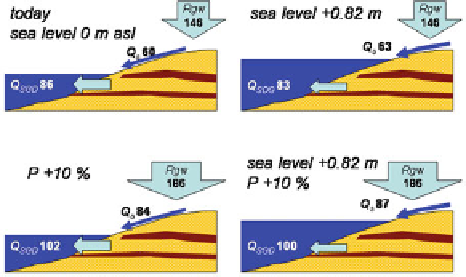Geoscience Reference
In-Depth Information
Fig. 19.4
Impact of sea-level
rise on submarine
groundwater discharge
(Schematic cross section of
the model area.
P
precipitation,
R
GW
groundwater recharge,
Q
SGD
submarine groundwater
discharge,
Q
S
surface runoff,
mass balance terms in
[mm/a])
chosen because Modflow allows for time-variant specified heads (first kind bound-
ary condition) within stress periods (Leake and Prudic
1991
). The model geometry
is simplified because the focus of this study is to understand the general mechanisms
rather than the specific test site at Wismar Bay.
A 100 year period is simulated during which (i) the sea level rises from 0 m asl
up to 1 m asl, (ii) the average annual groundwater recharge increases 30%, i.e. from
150 mm/a up to 195 mm/a and finally (iii) both scenarios are combined.
The model area is of the same size as the true catchment (140 km
2
), subdivided
into 100 by 140 finite-difference cells, each 100 m by 100 m. The top row (North)
is defined as time-variant specified head boundary (first kind) representing a 10 km
long coastline with sea-level rise of 1 m in 100 years. The Modflow code allows
linearly varying head values during transient simulation. Surface runoff
Q
S
is rep-
resented by one central river of 10 km length, which is simulated by a third kind
boundary condition.
The aquifer is represented by one single unconfined layer with a homogeneous
hydraulic conductivity of 1
.
10
-4
m/s. The bottom of this layer is assumed to be at
×
-10 m asl.
Figure
19.5
illustrates the model design and the resulting hydraulic heads after
100 years simulation period. The heads range from 78 m asl in the south to sea
level in the north. According to Eq. (
4
) and similar to the steady-state FE model, the
amount of groundwater which drains into the central river is accounted for as sur-
face runoff (
Q
S
). The model is adjusted to starting conditions which reflect today's
conditions as calculated with the steady-state FE model, i.e. surface runoff amounts
to 40% of total discharge.
The transient simulation of the response of submarine groundwater discharge
to changes in groundwater recharge and/or sea-level rise confirms the steady-state
results. Given the predicted scenarios, a sea-level rise of 1 m does not affect
groundwater discharge significantly. Conversely, the rise in net water inflow, i.e.
groundwater recharge, leads to a significant increase of both surface runoff and sub-
marine groundwater discharge. However, the absolute increase slightly favours the
submarine groundwater discharge (Fig.
19.6
).

